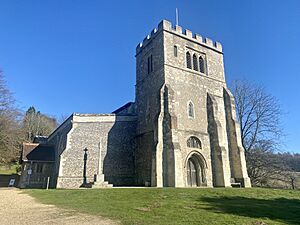Church of St Peter and St Paul, Great Missenden facts for kids
Quick facts for kids Church of St Peter and St Paul |
|
|---|---|
 |
|
| 51°42′03″N 0°41′56″W / 51.7008°N 0.6988°W | |
| OS grid reference | SP 90015 01038 |
| Country | United Kingdom |
| Denomination | Church of England |
| Churchmanship | Liberal Catholic |
| Website | St Peter and St Paul |
| History | |
| Dedication | St Peter and St Paul |
| Architecture | |
| Heritage designation | Grade I listed |
| Specifications | |
| Capacity | 250 |
| Administration | |
| Parish | Great Missenden with Ballinger and Little Hampden |
| Deanery | Wendover |
| Archdeaconry | Buckingham |
| Episcopal area | Buckingham |
| Diocese | Oxford |
| Province | Canterbury |
The Church of St Peter and St Paul is a special Church of England church located in Great Missenden, Buckinghamshire, England. It is a very old and important building. The church is listed as a Grade I building. This means it is considered to be of exceptional historical interest.
Contents
Discovering the Church of St Peter and St Paul
A Glimpse into the Church's Long History
This church was mostly built in the 1300s. Its height was increased in the 1400s. After the English Reformation, the church tower was extended towards the south. This made one wall almost 14 feet thick. This strong wall was needed to hold a new bell tower. This new belfry housed five bells. These bells were moved from the nearby Missenden Abbey after it was closed down.
The church underwent major repairs and updates between 1899 and 1900. A famous architect named John Oldrid Scott led this work. During this time, the north-east aisle of the church was rebuilt.
Building Materials and Design
The church is built using flint rubble. This means it uses rough, broken pieces of flint stone. It also has sarsen stone at its base. Some parts are covered in a rough coating called roughcast. Other parts use smooth, cut stone blocks called ashlar.
Famous Connections: Roald Dahl and More
The famous writer Roald Dahl lived in Gipsy House in Great Missenden. He is buried in the churchyard of St Peter and St Paul. Many people visit his grave.
The churchyard also has two special memorials. These are from the Commonwealth War Graves Commission. They mark the burial places of two British soldiers. One memorial is for Rifleman Jeffrey James Whitney. He was part of the Rifle Brigade and died in September 1940 at age 20. The other is for Major Basil Arthur Parnwell. He was from the Royal Fusiliers and died in July 1947.

